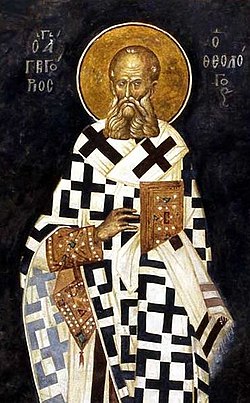Gregory of Nazianzus
Christian saint and theologian (c. 329 – 390) From Wikipedia, the free encyclopedia
Gregory of Nazianzus (329 – January 25, 389 or 390), also known as Gregory the Theologian or Gregory Nazianzen or Gregory Nazianzen (Greek: Γρηγόριος Ναζιανζηνός - Grēgorios Nazianzēnos ) was the Archbishop of Constantinople in the 4th century. He was considered one of the typical Church Fathers in terms of eloquence.: xxi Being classically trained philosopher and preacher, he infused Hellenism into the early Church and was well-known among Byzantine prelates and theologians.[4]: xxiv
Gregory of Nazianzus | |
|---|---|
 | |
| |
| Born | 329 Arianzum, Cappadocia |
| Died | 25 Jan 389/390 Arianzum, Cappadocia |
| Honored in | |
| Major shrine | St. George's Cathedral, Istanbul at Fanar |
| Feast |
|
| Attributes | Vested as a bishop, wearing an omophorion; holding a Gospel Book or scroll. Iconographically, he is depicted as balding with a bushy white beard. |
Gregory had an crucial impact on the model of Trinitarian theology, for both Greek and Latin church. Many of his theological works still continue to influence theologians today, especially on the issue of the relationship between Trinity.
Gregory was venerated in both Eastern and Western Christianity. Together with Basil the Great and Gregory of Nyssa, he was known as the Fathers of Cappadocia . In Roman Catholicism, he was considered as Doctor of the Church. Eastern Orthodoxy and Eastern Catholicism honored him as one of Three Holy Hierarchs along with Basil the Great and John Chrysostom.
References
Wikiwand - on
Seamless Wikipedia browsing. On steroids.
